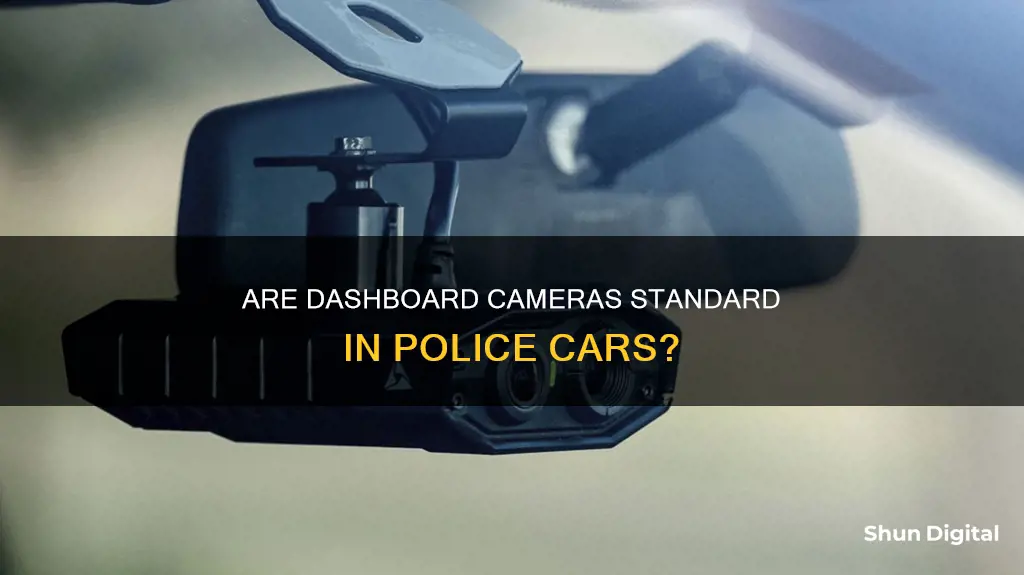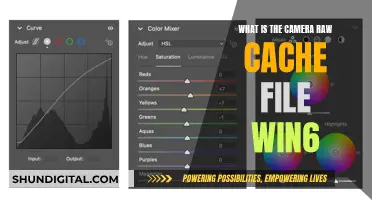
In-car police cameras, or dash cams, are an increasingly common feature of police vehicles. In the US, 72% of state patrol vehicles now have in-vehicle camera systems, up from 11% in 2000. While the technology is not yet standard across all police forces, it is becoming more affordable and offers a range of benefits for law enforcement, including improved evidence gathering, better officer training, and greater accountability.
| Characteristics | Values |
|---|---|
| Percentage of state police and highway patrol vehicles with in-vehicle camera systems in 2000 | 11% |
| Percentage of state patrol vehicles with in-vehicle camera systems now | 72% |
| Purpose | To provide evidence, improve officer safety, reduce complaints, increase transparency and accountability, and deter and investigate crime |
| Dashboard camera footage benefits | Protects officers and citizens, improves police standards, de-escalates tensions, reduces complaints, improves relationships with the community, and saves costs |
| Dashboard camera features | Can be triggered by turning on emergency lights and siren, can be manually activated, can record in low-light conditions, can be integrated with wireless technology, can be used inside and outside the vehicle |
What You'll Learn
- Police dash cams can prevent false accusations and protect both officers and the public from these
- They can also help to de-escalate situations and improve the behaviour of both officers and citizens
- Dash cams can provide an objective account of incidents, which can be used as evidence in court
- They can be automatically activated by triggers, such as emergency lights and sirens being turned on
- Dash cams can also help to improve officer training and performance

Police dash cams can prevent false accusations and protect both officers and the public from these
Police dash cams are an increasingly popular technology used by law enforcement agencies. They have been shown to be effective in preventing false accusations and protecting both officers and the public.
Dash cams provide an objective account of incidents, capturing footage from both inside and outside the police vehicle. This helps to deter criminal activity as individuals are less likely to act out when they know their actions are being recorded. The footage can also be used to prove innocence or guilt in court, ensuring justice is served for all parties involved.
In the case of traffic stops or investigations, dash cams can be used to provide evidence of any violations or incidents. This can help to protect civilians from false accusations or unfair treatment by officers. Additionally, civilians can request that all interactions with officers take place in front of the dash cam, ensuring transparency and accountability in police conduct.
The presence of dash cams has been found to improve the professionalism of police officers and reduce complaints against them. The footage can be used to maintain and improve police standards, providing insights into disciplinary issues and training needs. It also helps to maintain a positive relationship with the community by promoting policy accountability and transparency.
Furthermore, dash cams can capture important details across a wide range of lighting conditions, including at night, thanks to advanced features such as HDR recording and infrared LEDs. This ensures that vital evidence is not missed, further contributing to the accuracy and reliability of the footage captured.
In summary, police dash cams offer numerous benefits that help to prevent false accusations and protect both law enforcement officers and the public. By providing objective accounts, deterring criminal activity, and improving police professionalism, dash cams are an invaluable tool for promoting transparency, accountability, and safety in policing.
Campark Cameras: Where Are They Manufactured?
You may want to see also

They can also help to de-escalate situations and improve the behaviour of both officers and citizens
The presence of dashboard cameras in police cars has been shown to have a de-escalating effect on confrontational situations. This is true for both officers and citizens, with the knowledge of being recorded often resulting in more courteous behaviour.
A study by the International Association of Chiefs of Police (IACP) found that in-car video systems resulted in greater professionalism by police and fewer complaints against them by members of the public. The presence of video recording devices was found to de-escalate tensions, with some officers reporting that both they and the public remained more courteous when being filmed.
In addition to improving behaviour during police-citizen interactions, dashboard cameras can also positively impact officer behaviour when no members of the public are present. For example, a study by Justin Ready and Jacob Young from Arizona State University found that officers with body-worn cameras were more cautious in their actions and more sensitive to possible scrutiny of video footage by their superiors.
Furthermore, dashboard cameras can also help improve the behaviour of citizens towards officers. One study found that citizens often change their behaviour towards officers when they are informed that the encounter is being recorded. This can help prevent certain situations from escalating to levels that require the use of force.
Overall, dashboard cameras have been shown to be an effective tool for de-escalating situations and improving the behaviour of both officers and citizens. By providing an objective record of interactions, these cameras can help keep both law enforcement officers and citizens safe.
Focusing Bunker Hill Cameras: Tips for Optimal Surveillance
You may want to see also

Dash cams can provide an objective account of incidents, which can be used as evidence in court
The use of dash cams in police cars has been a topic of discussion and debate. While some people argue that all police cars should be equipped with dash cams, others point to the financial, legal, and technical challenges that may hinder their implementation. However, there is no denying that dash cams can play a crucial role in providing an objective account of incidents, which can be valuable in court proceedings.
Dash cams are capable of recording high-definition footage, often in Full HD (1080p) with HDR (High Dynamic Range) support, ensuring that important details are captured clearly across varying lighting conditions. This high-quality footage can make all the difference when it comes to providing evidence in court. It can help protect citizens from false accusations and hold officers accountable for their actions. In the event of a complaint, dash cam footage can be reviewed to determine the validity of the grievance, potentially saving time and resources in the process.
The objective nature of dash cam footage is particularly important when it comes to police work. It can provide an unbiased perspective of incidents, capturing not only the road ahead but also the interior of the vehicle. This can be crucial in monitoring police conduct and ensuring the safety of both officers and citizens. The presence of dash cams can also have a positive impact on behaviour, encouraging both officers and citizens to act with greater professionalism and courtesy.
Additionally, dash cams can aid in evidence gathering and investigative processes. They can capture crucial details such as vehicle speed, braking patterns, steering direction, road conditions, and even seat belt usage. This information can be essential in reconstructing events, determining liability, and supporting legal claims. Dash cam footage can also assist in securing convictions, improving the effectiveness of police departments, and enhancing operational efficiency.
In summary, dash cams have the potential to revolutionise police work by providing objective accounts of incidents. The evidence captured by these devices can be invaluable in court proceedings, helping to protect citizens, hold officers accountable, and ensure fair and transparent legal processes. While there may be challenges to implementing dash cams in all police cars, the benefits they offer in terms of objectivity, evidence, and accountability cannot be overlooked.
Selecting Camera Landscapes: Camera Raw Tips
You may want to see also

They can be automatically activated by triggers, such as emergency lights and sirens being turned on
The integration of technology in law enforcement is essential for enhancing transparency, accountability, and community trust. In-vehicle dash cams are not a new invention, but their growing popularity with motorists and law enforcement is linked to improved technology and reduced costs. Dash cams are now more affordable and offer improved video and audio quality, making them an essential tool for crime deterrence and investigation.
Dash cams can be automatically activated by triggers, such as emergency lights and sirens being turned on. This is possible because dash cams are hardwired into a vehicle's electrical system, allowing them to be programmed to activate based on specific triggers. This feature ensures that every incident is recorded, providing an objective account of events and protecting both officers and citizens.
However, not all dash cameras have this automatic activation capability. Some cameras require manual activation by the officer, and the automatic triggering may not always work as expected. Nevertheless, the benefits of dash cams with automatic triggers are significant. They ensure that critical situations, such as high-speed pursuits or emergency responses, are recorded from the moment the emergency lights and sirens are activated. This provides valuable evidence, enhances officer safety, and improves the transparency of law enforcement operations.
The automatic triggering feature also reduces the risk of human error or forgetfulness, ensuring that even in high-pressure situations, the camera is always recording when it is needed most. This capability aligns with the broader trend of integrating technology into law enforcement, demonstrating a commitment to accountability and public safety.
In conclusion, the ability of dash cams to be automatically activated by triggers like emergency lights and sirens is a significant advancement in law enforcement technology. While not all dash cams have this feature, its availability underscores the importance of staying current with technological advancements to improve policing and maintain community trust.
Dodge Charger GT: Reverse Camera Availability
You may want to see also

Dash cams can also help to improve officer training and performance
The use of dash cams in police vehicles has been a topic of discussion and implementation over the years, with many law enforcement agencies in the United States and worldwide adopting this technology. Dash cams have proven to be a valuable tool for law enforcement, offering a range of benefits that extend beyond evidence gathering. One significant advantage of dash cams is their ability to improve officer training and performance.
Dash cams provide a unique opportunity for police trainers to develop reality-based training scenarios that are grounded in actual events. The footage captured by these cameras offers a wealth of information and insights into police-citizen interactions, allowing trainers to identify teaching points and areas for improvement. By reviewing dash cam videos, trainers can create comprehensive training programs that cover a range of situations, from routine interactions to critical incidents.
The use of dash cam footage in training provides officers with immediate feedback on their performance, enabling them to learn from their mistakes and develop better habits. It also allows trainers to highlight positive behaviours and successful tactics employed by officers in the field. This level of detail and realism in training helps to improve the skills and decision-making abilities of officers, ultimately enhancing their performance in real-world situations.
Additionally, dash cams can assist in identifying specific training needs within police departments. By analysing patterns and trends in the footage, trainers can tailor their programs to address common challenges faced by officers. This adaptive training approach ensures that officers receive relevant and practical instruction, improving their overall effectiveness in their duties.
The presence of dash cams in police vehicles also encourages a culture of professionalism and accountability among officers. Knowing that their interactions are being recorded can motivate officers to maintain high standards of conduct and adhere to established protocols. This self-awareness can lead to more positive outcomes in police-citizen encounters and improve the public's perception of law enforcement.
In conclusion, dash cams are a valuable tool for law enforcement agencies, not only for evidence gathering but also for enhancing officer training and performance. By utilising dash cam footage, police departments can develop comprehensive training programs, promote professionalism, and improve the overall effectiveness of their officers, ultimately leading to better outcomes for both the officers and the communities they serve.
Attaching a Mod Camera Strap: A Quick Guide
You may want to see also
Frequently asked questions
No, not all cop cars have dashboard cameras. While the technology has been available for some time, dash cams are yet to become standard across the world's police forces.
There are a variety of reasons why police forces might not adopt dash cam technology, including political, legal, financial, and technical factors.
Dash cams can provide an objective account of incidents, protecting both officers and citizens. They can also help to de-escalate situations and improve police conduct, as well as reduce complaints. Additionally, they can strengthen cases and secure convictions, improving the effectiveness and performance of police departments.
Some people may view dash cams as an invasion of privacy. There may also be concerns about the cost of implementing and maintaining the technology, as well as the time and resources required to review and manage the footage.
Modern dash cams can record in Full HD (1080p) at up to 50 frames per second, providing high-quality footage. They also support HDR (High Dynamic Range) recording, allowing them to capture important details across a wide range of lighting conditions. Advanced dash cams can also provide vehicle telematics data, such as engine speed and tire pressure, and integrate with cloud-based systems for real-time data analysis and sharing.







